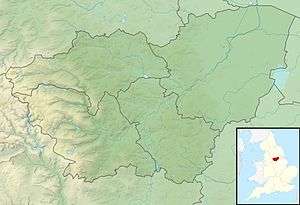Ulley Reservoir
| Ulley Reservoir | |
|---|---|
 | |
 Ulley Reservoir Location in South Yorkshire | |
| Location | South Yorkshire |
| Coordinates | 53°22′48″N 1°18′50″W / 53.3800°N 1.3140°WCoordinates: 53°22′48″N 1°18′50″W / 53.3800°N 1.3140°W |
| Type | reservoir |
| Primary inflows | Ulley and Morthen brooks |
| Basin countries | United Kingdom |
| Surface area | 35 acres (14 ha) |
| Average depth | 46 feet (14 m) |
Ulley Reservoir is a reservoir located a few hundred metres to the west and downhill of the village of Ulley, 4 miles (6.4 km) south of Rotherham, South Yorkshire, England. It is 2.5 miles (4 km) away from junction 33 of the M1 motorway.
History
The reservoir was built in 1871 by damming the brooks of Ulley and Morthen, to provide the town of Rotherham with approximately 180 million gallons (820 million litres) of drinking water per year.[1][2] There are two main ponds, the larger one is used for angling and dinghy sailing, and the smaller one is now a nature reserve.[3]
The dam is an earth embankment made of a clay core and earth filled shoulders. In 1969 the dam wall was built up by 6.6 feet (2.0 m) with plastic concrete and relevelled. The spillways and overflow are made of ashlar pitching set on concrete. It is 41.3 feet (12.6 m) in height with a slope of 12.7 degrees, with two lateral overflow stepped spillways.[4] The reservoir covers an area of 35 acres (14 ha) and is about 46 feet (14 m) deep.[5]
In the 1980s it was decided that it was no longer needed for water supplies and was sold to Rotherham council for £1. The council turned the venue into the centrepiece of Ulley Country Park, with the water hosting sailing and fishing.
Ecology
The reservoir and the surrounding country park are a haven for a variety of wildlife. Over 150 species of flowering plants have been recorded in the park, creating an abundance of both insects and butterflies. The bird species include; mallard, tufted duck, little grebe, great crested grebe, coot, moorhen, dragonfly, kingfisher, grey heron, swallow, swift, house martin and kestrel.[6]
June 2007 cracks in the dam
On 25 June 2007, cracks in the reservoir walls were found after heavy rains and flooding in the area, causing concerns that the reservoir might burst, prompting the evacuation of the three nearest villages Whiston, Treeton and Catcliffe. Several other areas as far away as Canklow were put on emergency flood alert. The M1 motorway was also closed between junctions 32 and 36 amid fears over safety.[7] This led to 700 local residents being evacuated from their homes.[8] Fire crews used seventeen high volume pumps to remove four million litres of water per hour from the reservoir.[9]
The possibility of the dam being susceptible to cracking had been discussed in 1970, at a conference about problems with dams of a similar age and construction.[10]
It was feared that, if the reservoir's dam was breached, the sudden flow of water could bring down high voltage power lines, and flood the nearby M1 and a crucial regional electricity substation, which supplies the power to the whole of Sheffield.
References
- ↑ "South Yorkshire & North Derbyshire Local Environment Agency Plan" (PDF). Environment Agency. Archived from the original (PDF) on 27 June 2007. Retrieved 26 June 2007.
- ↑ "history". Ulley Country Park. Retrieved 26 June 2007.
- ↑ "Ulley Pond". Retrieved 26 June 2007.
- ↑ Chanson, H; Whitmore, R.L. (August 1998). "Gold Creek Dam and its Unusual Waste Waterway (1890–1997) : Design, Operation, Maintenance" (PDF). Canadian Journal of Civil Engineering. 25 (4): 755–768. doi:10.1139/cjce-25-4-755. Retrieved 26 June 2007.
- ↑ "Thousands evacuated as dam threatens to burst its banks". This is London. Retrieved 26 June 2007.
- ↑ "history". Ulley Country Park. Retrieved 26 June 2007.
- ↑ "Hundreds flee over dam burst fear". BBC News Online. 26 June 2007. Retrieved 16 February 2014.
- ↑ "Flood latest: residents face second night away from home". Yorkshire Post. Retrieved 26 June 2007.
- ↑ "Dam families' second night away". BBC News. 27 June 2007. Retrieved 26 June 2007.
- ↑ "Cracking of clay cores of dams" (PDF). British Geotechnical Society. 1970. Retrieved 26 June 2007.
External links
- Ulley Country Park
- Ulley Sailing Club
- Gold Creek Dam and its Historical Stepped Spillway
- Chanson, Hubert and Whitmore, Ray L. (1998). Gold Creek Dam and its Unusual Waste Waterway (1890–1997): Design, Operation, Maintenance. Canadian Journal of Civil Engineering, 25 (4), 755–768.